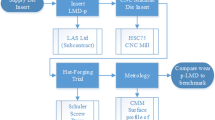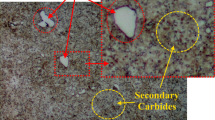Abstract
In the aluminum porthole extrusion process, excessive wear occurs on the surface of mandrel. This study evaluates the applicability of direct metal deposition (DMD), a 3D printing process, for repairing the hot aluminum extrusion die. The wear characteristics of three die repairing methods (parent-STD61, DMD-STD61, and welded-STD61) were compared through a high-temperature pin-on-disk wear test that considers the aluminum extrusion temperature. The results confirm that DMD results in superior wear characteristics when compared to overlay welding repair method. Further, the wear resistance of DMD-STD61 is similar to that of parent-STD61. The application of the DMD process is expected to yield a wear life similar to that of the parent STD61.
Similar content being viewed by others
References
J. C. Choi and B. M. Kim, Tool life in metal forming processes, Transactions of Materials Processing, 3 (2) (1994) 147–155.
Z. Gronostajski, M. Kaszuba, S. Polak, M. Zwierzchowski, A. Niechajowixz and M. Hawryluk, The failure mechanisms of hot forging dies, Materials Science Engineering: A, 657 (7) (2016) 147–160.
D. H. Kim, H. C. Lee and B. M. Kim, Estimation of die service life against plastic deformation and wear during hot forging processes, Journal of Materials Processing Technology, 166 (20) (2005) 372–380.
H. Kashani, A. Amadeh and H. Ghasemi, Room and high temperature wear behaviors of nickel and cobalt base weld overlay coatings on hot forging dies, Wear, 262 (7–8) (2007) 800–806.
R. Ebara and K. Kubota, Failure analysis of hot forging dies for automotive components, Engineering Failure Analysis, 15 (7) (2008) 881–896.
S. Thompson, Handbook of mould, tool and die repair Welding, Woodhead Publishing Ltd. (1999).
D. G. Ahn, Applications of laser assisted metal rapid tooling process to manufacturing of molding & forming tools, International Journal of Precision Engineering and Manufacturing, 12 (5) (2011) 925–938.
D. G. Ahn, Direct metal additive manufacturing processes and their sustainable applications for green technology: A Review, International Journal of Precision Engineering and Manufacturing-Green Technology, 3 (4) (2016) 381–395.
J. H. Choi and Y. S. Chang, Analysis of laser control effects for direct metal deposition process, Journal of Mechanical Science and Technology, 20 (10) (2006) 1680–1690.
D. S. Shim, G. Y. Baek, J. S. Seo, G. Y, Shin, K. P. Kim and K. Y. Lee, Effect of layer thickness setting on deposition characteristics in direct energy deposition (DED) process, Optics & Laser Technology, 86 (2016) 69–78.
Y. Z. Zhang, Y. T. Liu, X. H. Zhao and Y. J. Tang, The interface microstructure and tensile properties of direct energy deposited TC11/Ti2AlNb dual alloy, Materials & Design, 110 (2016) 571–580.
J. X. Fang, S. Y. Dong, Y. J. Wang, B. S. Xu, Z. H. Zhang, D. Xia, W. B. Ren and P. He, Microstructure and properties of an as-deposited and heat treated martensitic stainless steel fabricated by direct laser deposition, Journal of Manufacturing Processes, 25 (2017) 402–410.
M. K. Imran, S. Masood, M. Brandt, S. Bhattacharya and J. Mazumder, Parametric investigation of diode and CO2 laser in direct metal deposition of H13 tool steel on copper substrate, International Journal of Mechanical, Aerospace, Industrial, Mechatronic and Manufacturing Engineering, 5 (7) (2011) 1524–1529.
J. H. Jang, B. D. Joo, S. M. Mun, M. Y. Sung and Y. H. Moon, Application of direct laser melting to restore damaged steel dies, Metals and Materials International, 17 (1) (2011) 167–174.
C. Selcuk, Laser metal deposition for powder metallurgy parts, Powder Metallurgy, 54 (2) (2011) 94–99.
J. S. Park, J. H. Park, M. G. Lee, J. H. Sung, K. J. Cha and D. H. Kim, Effect of energy input on the characteristic of AISI H13 and D2 tool steels deposited by a directed energy deposition process, Metallurgical and Materials Transactions A, 47 (5) (2016) 2016–2529.
J. Mazumder, J. Choi, K. Nagarathnam, J. Koch and D. Hetzner, The direct metal deposition of H13 tool steel for 3-D components, JOM, 49 (5) (1997) 55–60.
J. Mazumder, A. Schifferer and J. Choi, Direct materials deposition: designed macro and microstructure, Materials Research Innovations, 3 (3) (1999) 118–131.
Y. T. Yoo and H. J. Shin, A Study on the characteristics of repair welding for mold steel using continuous wave Nd:YAG laser, Journal of the Korean Society for Precision Engineering, 27 (7) (2010) 7–16.
D. G. Ahn, S. H. Kim and H. J. Lee, A preliminary study on the application of three-dimensional (3D) printing technologies to hot bulk forming process -example of preform design and investigation of hot-working tool steel deposited surface, Journal of the Korean Society for Precision Engineering, 31 (12) (2014) 1093–1100.
D. G. Ahn, H. J. Lee, J. R. Cho and D. S. Guk, Improvement of the wear resistance of hot forging dies using a locally selective deposition technology with transition layers, CIRP Annals–Manufacturing Technology, 65 (1) (2016) 257–260.
J. H. Jang, B. D., Joo, C. J. Van Tyne and Y. H. Moon, Characterization of deposited layer fabricated by direct laser melting process, Metals and Materials International, 19 (3) (2013) 497–506.
J. S. Park, M. G. Lee, Y. J. Cho, J. H. Sung, M. S. Jeong, S. K. Lee, Y. J. Choi and D. H. Kim, Effect of heat treatment on the characteristics of tool steel deposited by the directed energy deposition process, Metals and Materials International, 22 (1) (2016) 143–147.
H. H. Jo, S. K. Lee, S. B. Lee and B. M. Kim, Prediction of welding pressure in the non-steady state porthole die extrusion of Al7003 tubes, International Journal Machine Tools and Manufacture, 42 (6) (2002) 753–759.
J. Yu, G. Zhao and L. Chen, Analysis of longitudinal weld seam defects and investigation of solid-state bonding criteria in porthole die extrusion process of aluminum alloy profiles, Journal of Materials Processing Technology, 237 (2016) 31–47.
J. M. Lee, S. W. Lee, Y. K. Kim, W. H. Jo, C. J. Lee and B. M. Kim, Extrusion of AA3003 mirco condenser tube with multi-hole and thin wall section using porthole die, International Journal of Precision Engineering and Manufacturing-Green Technology, 3 (3) (2016) 239–245.
J. Yu, G. Zhao and L. Chen, Analysis of longitudinal weld seam defects and investigation of solid-state bonding criteria in porthole die extrusion process of aluminum Alloy profiles, Journal of Materials Processing Technology, 237 (2016) 31–47.
Z. Zang, L. Ren, H. Zhou, Z. Han, X. Tog, Y. Zhao and L. Chen, L. Effect of thermal fatigue loading on tensile behavior of H13 die steel with biomimetic surface, Journal of Bionic Engineering, 7 (4) (2010) 390–396.
Author information
Authors and Affiliations
Corresponding author
Additional information
Recommended by Associate Editor Young Whan Park
Sung-Yun Lee received his B.S. (2011) from Kyungil University, and his M.S. (2013) from Kyungpook National University, Korea. He is currently a researcher at the Extreme Fabrication Technology Group at Korea Institute of Industrial Technology (KITECH), and Ph.D. candidate of School of Convergence Science at Pusan National University, Korea. His major research is aluminum extrusion process.
In-Kyu Lee received his B.S. (2010) from International University, and his M.S. (2012) from Pusan National University, Korea. He is currently a researcher at the Extreme Fabrication Technology Group at Korea Institute of Industrial Technology (KITECH), and Ph.D. candidate of Department of Mechanical Engineering at Pusan National University, Korea. His research interests include cold/hot forging, die design technology.
Sang-Kon Lee received his B.S. (1998), M.S. (2000), and Ph.D. (2008) from Pusan National University in Korea. Dr. Lee is currently the Principal Researcher at the Extreme Fabrication Technology Group at Korea Institute of Industrial Technology (KITECH) in Korea. His major research field is metal forming technologies including wire and shape drawing, aluminum/ magnesium extrusion, and cold/hot forging processes.
Rights and permissions
About this article
Cite this article
Lee, SY., Lee, IK., Jeong, MS. et al. Wear characteristics of STD61 tool steel according to repairing methods for Al porthole extrusion die: Direct metal deposition, welding, parent material. J Mech Sci Technol 32, 2237–2244 (2018). https://doi.org/10.1007/s12206-018-0434-z
Received:
Revised:
Accepted:
Published:
Issue Date:
DOI: https://doi.org/10.1007/s12206-018-0434-z




